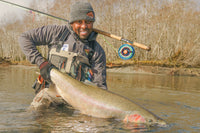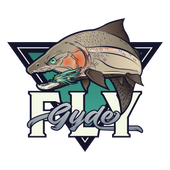Anglers with natural presentation in his or her mind as the key element for success while fishing ultimately will have more encounters. Entering the world below the water’s surface undetected allows you to fish as if an angler is not present at all. The Fly Fishing Technique of Euro or Czech Nymphing is without question the most effective technique for fishing in a river or stream for Steelhead and other species of Trout. If performed correctly, this method will entice fish to strike in sections of water previously thought to be void of fish.
Euro Nymphing began in the late 1800s as an alternative to catch fish that would not rise for a dry fly. The nymphs were fished subsurface upstream of Trout and drifted downstream to fish with a tight line, which facilitated a quick hookset. In later years the success of Euro Nymphing proved effective enough to enter the world stage in the mid-eighties at the World Fly Fishing Championships. The English coined the term “Czech Nymphing” after Czechoslovakian anglers secured numerous championships in the nineties, but other sources suggest the technique originated in Poland.
The Euro Nymphing casting technique differs from traditional single-hand fly fishing methods most anglers recognize. Euro Nymphing fly line includes minimal weight in grains, whereas other fly lines have a more significant grain weight. “10 & 2” does not apply here and can hinder the proper presentation rather than assist. Long leaders make the casting technique difficult as well. Some leaders are 15 feet or longer, depending on rod length and angler skill.
Your casting stroke will be with your dominant arm at eye level or above, parallel to your chest. Position your body in a manner that enables your opposite shoulder to face the targeted water. The cast, simply put, is a “Pop & Drop.” Begin making a typical cast. Pick up the line from the water and perform a backcast, then accelerate forward. The rod tip requires a “Pop” and lift at the end of your cast. As a result of the lift after the “Pop”, your nymphs reach the water first with a sharp “Drop” that quickly penetrates surface currents.
Euro Nymphing is performed with the intent of casting high above the water’s surface, upstream of fish. First, this is to enable a sharp “Drop” of the presentation. Secondly, this results in your nymphs or beads, getting deep where fish hold. In addition to the abrupt entry through the water, an upstream cast is needed. The upstream cast allows your presentation to move downstream, sinking naturally, as if uninhibited by your fly line. Enabling the drag-free drift is the crucial element to encountering more fish.
Leader setup following the choice of fly line is critical to your nymphing success. Understanding structure and river depth also assist in leader length choice and nymph spacing. The spacing of flies is only required if two or more hooks are allowed within fishery regulations.
From your reel lined with backing, select a Euro Nymphing Fly Line rated for your rod weight. Typically 3 to 6 weight rods and lines are used for Trout, and 6 to 8 weights are for Steelhead. If a Euro Nymphing Line is not available in a 6 to 8 weight, reverse any traditional fly line by attaching the head to your backing. The running line section now exiting the tip of your rod works well as a substitute due to its thin diameter.
Following your fly line is leader material. For Trout, this can be tapered monofilament. For Steelhead, we recommend a poly leader, which aids with casting distance required not to spook Steelhead, which can turn off the bite. Next is your sighter. The sighter is the section of leader needed to indicate strikes, depth, and the lateral direction your presentation is traveling downriver. Keeping a close watch on the sighter movement is key to understanding what action is required after an indication.
Most importantly, is to recognize feel, along with sighter movement. Strike indication can come from one of two places. First, it could be the fly line vibration in your non-dominant hand during the drift. Second, it could be the rod tip. If both the rod tip and fly line indication are simultaneously used, you will have a more significant advantage to detect strikes. The Euro Nymphing angler who uses feel, before sight, consequently reacts within a split second. Anglers only using sight reactions will undoubtedly have a slower hookset, which can lead to missed strikes.
Following the sighter is a section of stout fluorocarbon leader material, then tapered down to your tippet. Tippet can be attached to the leader following your sighter with a tippet ring, welded loop, or various fishermen’s knots. Tippet strength varies depending on the size of the targeted Trout or Steelhead. When choosing tippet length, have the average river depth in mind. Your goal is to have little or no sighter underwater and enough fluorocarbon tippet to reach the bottom.
Lastly, are your nymphs or beads, which have two options for attachment after your sighter.
Option one: Tie two isolated sections of different lengths to the tippet ring. One should be short and the other at least four times the length of the shorter section. This method is used for Steelhead, which enables full tippet strength with no line to line connections. Steelhead can reach sizes well over 20 pounds, and the stronger tippet with fewer connections provides a better landing ratio. Option two: Recommended only for small to mid-sized Trout. From your leader which follows your sighter or tippet ring tie in a long section of line to your bottom nymph. Finally, 18 to 28 inches above the bottom nymph tie in a shorter piece of tippet and attach a nymph or bead to the end.
Finding water suitable for Euro Nymphing can be challenging for the angler who is beginning to understanding river hydraulics. Over time you will recognize sections of water that hold fish and others that don’t. Euro Nymphing is a technique that can expand on a river or streams fishable sections because of the approach. To clarify, Euro Nymphing can be successful when all other methods are not.
For Trout, river position while Euro Nymphing can be in various places, but an ideal situation is as follows. Locate a section of river which includes large boulders and other structure for fish to hold. Fishing downstream of the structure is your best opportunity for success. Wading depth can vary, but typically you will not be further than thigh-high into the water a few feet away from the bank. A transition zone where the water gradually gains depth is a great place to start as well.
For Steelhead, locate water that includes a flat bottom, cobblestone sized rocks, boulders, and walking speed flows. River depth will be from 3 to 8 feet and above or below fast water. To fish effectively, attempt to have structure separating you from the targeted water. For instance, cast over the top of a boulder or log where you cannot wade. If possible, secure a position on the bank outside of the water. Fishing from an elevated position will enable you to walk when fishing for Steelhead and cover more water, faster. Steelhead numbers are lower than Trout, so more water needs to be covered to find fish.
Are you able to reach fish holding deep below surface flows if you are targeting water with an upwards moving current? For some techniques, the answer is no. For example, an indicator suspended nymph will be drawn downstream at a faster pace for a fish to strike even if proper mending occurs. A drifted or stripped streamer could be the answer, but an aggressive fish is required for a take. Euro Nymphing is the final check in the fly fishing world to determine whether there are fish or not. The natural presentation of this technique moves all fish, not only the “players.” If performed correctly with bottom contact, matched river speed, and still no strikes, it is now time to find new water that holds fish.
Begin casting upstream, tracking your nymphs with the rod tip throughout the drift while keeping a tight line. As your presentation moves downriver, follow the bottom contour by lowering the rod tip. If contact is detected, lift the rod slightly to bring your flies off the river bed. The moment your flies have left the bottom, search for a swift thump. What you are feeling is a fish taking your fly. Set the hook swiftly and battle the fish accordingly.
In conclusion, and most importantly, is that without a proper understanding of reading water and fish-holding patterns, you can have a great day of casting with nothing to show for it other than adequate technique. Reading water is what certainly separates “casters” from fishermen. Hiring a guide is a great option helping you to learn the subtle intricacies of reading water, and to boost your chances. There is no substitute for time on the water! At Fly Gyde, our partners and we have spent countless days chasing our passion and working hard to deliver you the result of those efforts.








READY TO FLY?
ONE CAST CAN CHANGE YOUR LIFE
We appreciate you reading our content and when you're ready, we're here to provide a memorable experience on the water.

PERSONAL SHOPPING EXPERIENCE
FROM THE BACKING
Step by Step Professional Guidance & Gear Section For Your Next Fishing Adventure With Us or On Your Own. Online or In-Person













































































